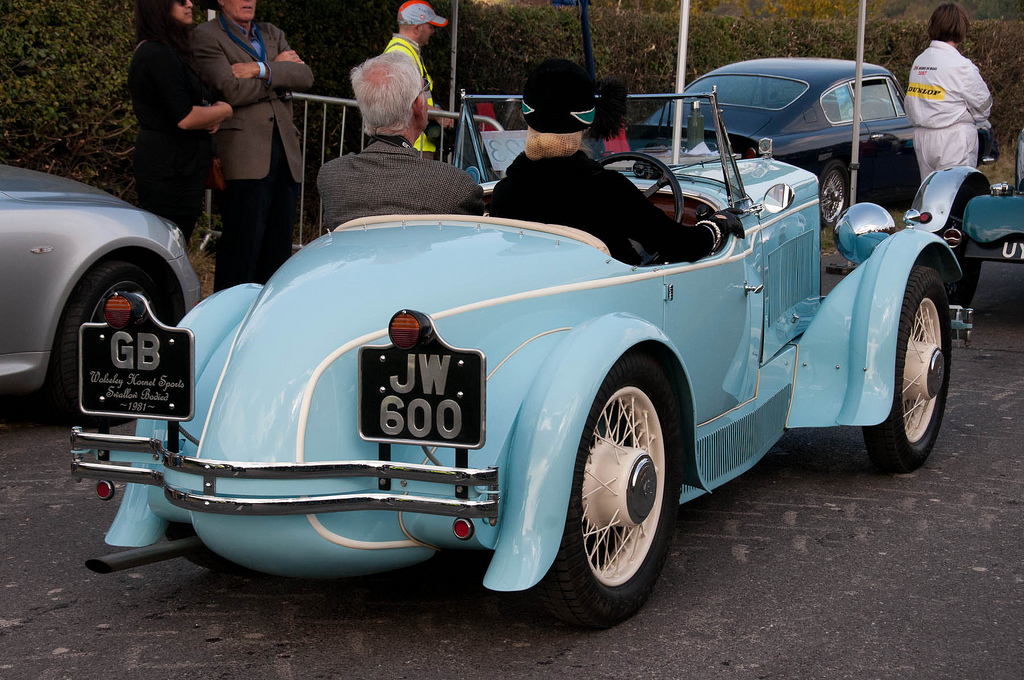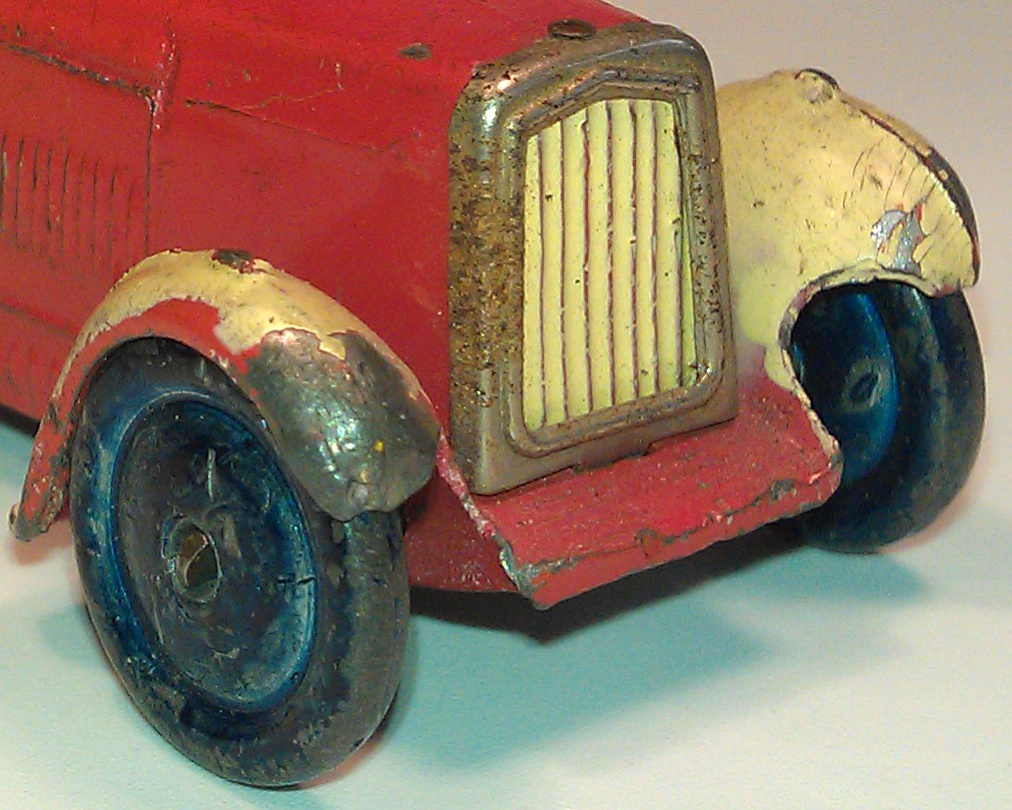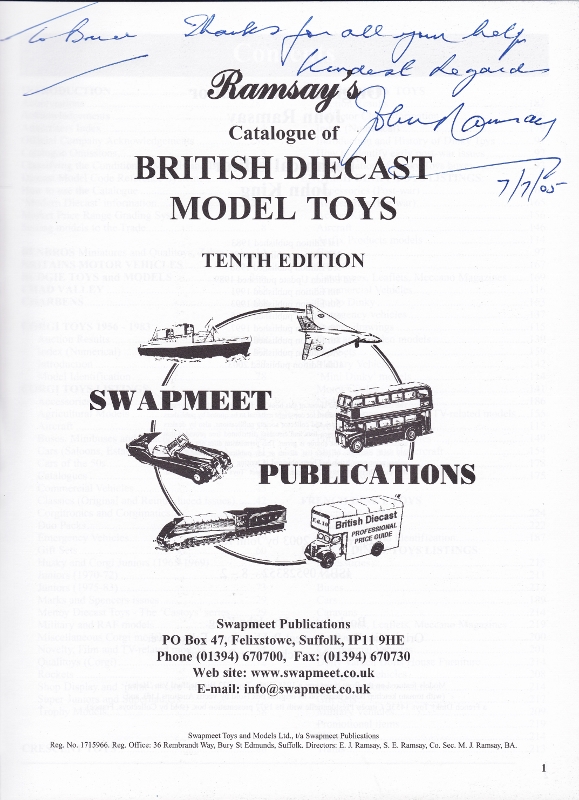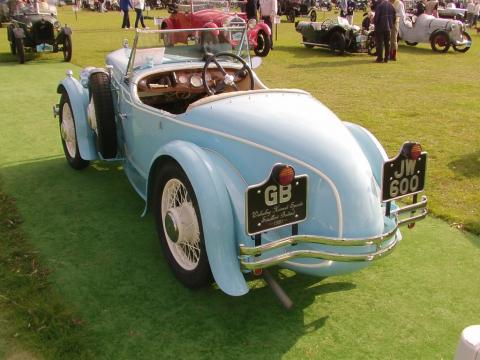--22a Open Sports Car (1933-35)


Wolseley Hornet Special Swallow 1931 – real one of Dinky Toys 22a Sports Car.

Dinky Toys 22a Sports Car.

Wolseley emblem.


Wolseley 1931 Hornet Swallow.

Dinky Toys 22a Sports Car.

Wolseley 1931-32 Hornet Swallow complete for GBP 225.

Wolseley Swallow Hornet coachwork. Complete GBP 225.
Note: An individual Dinky Toys 22a on Vectis auction was sold for GBP 750 on 18-5-2011. A model car nowadays 3 times more expensive than the original car at that time!!

1933 Hornby Series Modelled Miniatures 22a Sports Car – 1934 Dinky Toys 22a Sports Car
The 22a Sports Car was the first made Dinky Toys car and the Genesis of the famous Dinky Toys range of Meccano Liverpool. In fact, it was not yet a Dinky Toys, but Modelled Miniatures and belonged to the Hornby Series Modelled Miniatures No. 22 Set of 6 motor vehicles. It was announced in Meccano Magazine of December 1933. The set consisted of: Sports Car, Sports Coupé, Motor Truck, Delivery Van, Farm Tractor and Army Tank. The motor vehicles did not yet have an individual model number and were apparently only available as a set of six for 4 / -.

Meccano Magazine UK December 1933 part 1.

Meccano Magazine UK December 1933 part 2.

MM December 1933 No. 22 only for sale as set. No individual numbering yet.
Like the later 28 Series Delivery Vans, the 22a Sports Car is made of lead alloy that was not as prone to fatique as it did in other prewar models of that time. It measures 82 mm and weighs 92 grams. This is compared to a similar model, such as, for example, 38f Jaguar Sports Car of 53 grams, almost 2x so heavy.

Dinky Toys 22a Sports Car weighs 92 grams.

Dinky Toys 38f Jaguar Sports Car weighs 53 grams.
He has Hornby Series and Mecano Ltd Liverpool stamped inside cast instead of Dinky Toys and was intended as a toy accessory at the Hornby Railway Trains.

22a: Hornby Series and Meccano Ltd Liverpool inside cast.
He was performed in different colours, had a (vulnerable) open windshield, a shiny tinplate surround grille, metal disc wheels and was delivered in a beautiful box as a series of 6 different Motor Vehicles. For such a complete set in box on a Vectis Auction on 22-11-2011 was paid GBP 19,000.

Vectis auction No. 22 set with 22a sold on 22-11-2011 for GBP 19,000. 
The content of a No. 22 set with box as example.

Vectis auction 22a individual sold on 18-5-2011 for GBP 750.
Metal disc wheels were mounted on Dinky Toys in the beginning. Mounted on thin crimped axles they quickly lost their stability and the shrunk end of the crimped axles were (too) sharp for children.

22a with metal disc wheels (1934). Mine are blue colour washed.

Tootsietoys Graham Roadster 511 with cast wheels and rubber tires (1933).
The American Tootsietoys had already changed the disc wheels for better cast wheels with rubber tires.
In MM of April 1934, the name Dinky Toys is first mentioned in advertisements and set no. 22 is first referred to as Meccano Dinky Toys No. 22 Motor Vehicles. They then also received an individual model number: 22a Sports Car, 22b Sports Coupé, 22c Motor Truck, 22d Delivery Van, 22e Farm Tractor and 22f Army Tank and could be sold individually.
A loose 22a Sports Car costed 6d and the price for a complete set was 4 / -.

MM april 1934 with for the first time the name Dinky Toys 22a. Sold as set or individual.
Despite introduction of the name Dinky Toys they all stay marked "Hornby Series" instead of "Dinky Toys".

Hornby book of trains 1934-5 in colour with 22a as set or individual.

Meccano catalogue Dutch 1934-35 with 22a as set or individual. This time with a picture of 22a.

Meccano catalog UK 1934-35 very remarkable without 22a.
The 22a Sports Car was by Hornby not named to an existing automotive brand, but in the 3rd edition of John Ramsay's catalogue of British Diecast Model Toys (of which I have a by John Ramsay himself signed example from 1988) he is also in parentheses for the first time referred to as Wolseley Hornet and he is a vivid example of that car (see photo at the top).

In the 3rd edition of John Ramsay's catalogue of British Diecast Model Toys 22a is also in parentheses for the first time referred to as Wolseley Hornet.

3rd edition of John Ramsay's catalogue of British Diecast Model Toys signed by John Ramsay himself in 1988.
I always try to get a 1st edition of a model and I'm glad and proud to have this 1st model of Dinky Toys. He is very damaged, misses the windscreen, but is in its original condition and the colours are still bright and shiny. It is the beginning of the Dinky Toys history which means very much to me and I am happy that I can show now the beginning of the Dinky Toys history in this model.
Hoogvliet-Rotterdam 28-4-2017
Best wishes to all,
Jan Oldenhuis
Jan, what an interesting post. The Modelled Miniatures are in an unexplored area for me and this opened my eyes considerably. The Swallow company history is an interesting one, as I'm sure many are aware, and the Dinky 38f is based on a vehicle whose heritage can be traced to other Swallow-bodied cars, including the Wolseley. I have a photo of my father in an SS1 that he raced at Brooklands before the war.
Hello Jan,
Thanks very much for this interesting post. I did not know that the 22a Sports Car was modelled after the Wolseley Hornet Swallow. It is a good model for those days. It follows the lines of the original quite accurately. Being the first model in the 22 Series, it really is the start of Dinky Toys and deserves this post.
The Sports Car is the centre piece in the photo of my 22 Series Modelled Miniatures. I posted this photo before as "The start of a legend".
Kind regards,
Rob
John and Rob-Thanks for the comments.
I did not know where the abbreviation SS (Swallow Sidecars) came from in the name of the pre-war 38f SS Jaguar 100s until I read the comment from Jan Werner in TMT over the 38f. Understandably, this abbreviation in the post-war name of this beautiful car did not came back.
By chance, I made a comparison with the 38f Jaguar Sports Car in my comment about the 22a. Now it is clear to me that these two cars originated from the Swallow coachbuilding. Beautiful to discover such comparisons.
John it would be very nice to add a picture of your dad in the SS1. Rob you have a very nice collection of the 22 serie.
Kind regards,
Jan Oldenhuis
Jan, here is the photo of my father.
The inscription on the back of the photo states that this was a 1½ litre SS1 and it's dated 1937. It also states "Campbell Circuit", which was the road racing circuit constructed in the infield at Brooklands in that year so this would most probably have been taken at one of the short, handicap races that were held that year. The SS would have been given a 6 second start over the large-capacity cars. I have another photo, taken at the same meeting, of my father in a supercharged M-type MG Midget.
John-Thanks for the picture.
What is noticeable is, that the car has an open split radiator grille and does not have the long side mudguards, which model 38f normally does. Perhaps a special coach building for the racing matches.
I add a picture of a Jaguar SS100 of 1936. You see the initials SS and 100 on the badges of the Radiator grille.
Best Regards,
Jan Oldenhuis
What a beautiful car !
Richard
Having had a closer look at the SS models on the internet I have to say that maybe my father was slightly mistaken about which SS he was driving. To me the racer looks more like an SS2 than an SS1 and the fact that father describes the car as having a smaller engine than the SS1, which had 2-litre and 2½-litre six-cylinder engines, makes me think it was an SS2. That model used a chassis from the Standard 9hp and had a shorter bonnet due to its 4-cylinder engine.
Hello friends,
As Jan O. already mentioned there are two different inscriptions on the model 22a, Hornby series and Dinky toys. However there are other differences on this model. As I have both models in my collection, I can show these.
First picture shows the Dinky toys name. Also two injection points were Hornby has just one.
Second picture, note that the name is now under the boot and the other way round compared with the Hornby series. Under the bonnet you see a cross flow bar at the injection point.
Third picture. Hornby series, my model is smooth under the bonnet were Jan's model has a cross flow for better flow of the material.
Last picture the two models. Dinky toys is at the rear.
John.
John-this is very special. I had never seen this model, marked with Dinky Toys.
Mike Richardson also writes on page 26 in his book Dinky Toys & Modeled Miniatures the following remark: "Despite production of the Sports Car continuing into the year after the introduction of the name " Dinky Toys ", all are marked " Hornby Series " up underneath the bonnet."
So, I'm very happy with your contribution with pictures of 22a with "Dinky Toys" marked. In this case not under the bonnet, but under the rear. I did not expect this.
Congratulations with this acquisition. You have a very special model.
Best Regards, Jan Oldenhuis.
Hello Jan,
Thanks for your reply. All the models of serie 22 are not common. I have more in my collection with both Hornby Serie and Dinky Toys.
22a Sports car: Hornby Serie and Dinky Toys. 22d Delivery Van (no advertising) Hornby serie and Dinky toys, 22e Tractor Hornby series and Dinky Toys, 22f Tank Hornby serie and Dinky Toys. 22b Sports coupe and 22c Motor truck, I just have models with Hornby Serie, but I presume these models also exist with Dinky Toys name. From the Tank and Tractor you find most with Dinky Toys name as these were produced until 1940. The other four models were only made late 1933-1935 and thus much rarer.
The label on the Set 22 Modelled Miniatures is well known. I have a box lid with label for No 24 Motor cars with Modelled Miniatures. Must be extreme rare and I have never found serie No 24 cars with inscription Hornby. See picture. All 22 models can be seen on the label.
On the Train items you also find both names as they were already for sale before the set No 22 came on the market. subsequently the inscription on these models also changed from Hornby series to Dinky Toys.
John.
John-Thank you for your welcome addition.
This is very valuable information about Hornby-Dinky Toys's first motor vehicles and you have again a rare acquisition with the No. 24 box. You have a very complete collection from the Hornby-Dinky Toys beginning period.
Very special the pictures of the No. 22 Series on a box of the 24 Hornby Series. No model on the box was given the number 24. There are more examples from the prewar beginning of such a strange box. I found on Vectis this example of a No.25 box on 29-10-2009 auctioned for GBP 3000. This image of the 22 series does ofcourse also not match the contents of the box No.25. There is always something new from Dinky Toys.
10-5-2017 - Jan Oldenhuis
Jan
Thank you so much for a wonderful dissertation of the 1931 Wolseley Hornet Swallow, represented by the Hornby Series – Modelled Miniatures - Dinky Toys 22a Sports Car. You have done an excellent job taking us through its birth and with one particular model, its continued life in your care. What stories this little car could relate and the owners who have shared the same sort of pride as you obviously have.
I was surprised to read that John Ramsay’s 3rd Edition catalogue referred to the model in parenthesis by its name, Wolseley Hornet,

and yet by the 5th and subsequent editions, its name as well as the Jaguar’s had been omitted.

I can only speculate as to why this came about with the 22a, one possibility being its name, as a number of coach-builders sold their versions of the Wolseley Hornet including Swallow, Jensen and Boyd-Carpenter with Wolseley manufacturing the chassis, engine and running train, partly using their own factory names. This is shown with the advertisements included in your Post as we see the Wolseley Hornet Swallow at a cost of ₤225, and then another advertisement with the cars being referred as a Hornet Swallow. This confusion continues as shown with the following advertisement,

which refers to the cars as a Swallow Hornet!
It was a very common practice before WW2 for car manufacturers in the UK and other countries including Australia licensing coach-builders to build the bodies of their products. This was of special interest in Australia as the Australian government in 1917 had imposed an embargo on the importation of complete motor vehicles. This was designed to increase employment opportunities as well as providing a training ground for new employment in an industry that was just developing – mass motor vehicle production. One notable example being Holden’s Motor Body Builders Limited that formed a partnership with General Motors Australia in 1923 and then in 1931 as a result of the onset of the Depression, GMA purchased Holden’s Motor Body Builders Limited and thus GMH, General Motors Holden’s was formed. In 1948 through economic assistance from the Australian government, GMH launched its own Australian designed (albeit approved by GM in Detroit) car, the Holden, the name being chosen due to its Australian connection. These days from October this year Holden will become a name only with its badge trade mark the only thing manufactured in this country that will be affixed to imported Opels etc. I can only speculate why General Motors Holden’s has not returned to its original name, General Motors Australia, as the real Holden motor car will cease to exist, although I feel this is purely a marketing exercise to keep the appearance that it is an Australian company.)
Referring back to John Ramsay’s British Diecast Catalogues, two of John’s catalogue editions take pride of place on my book shelf – these being the last before he handed the reins to the Warner group. My apologies for including the inscriptions but I wanted to share it with you.

John – thank you for posting the photograph of your Dad in the 1½ litre SS1. You are certainly very fortunate to have such a close family connection with a part of British motor racing history. As for the car, for what it is worth, I think your Dad did make an error in identifying the car as a SS1 when I think was in fact a sports version of the SS2. The image below is of a touring version of the SS2 which clearly shows that this version had a different style of mudguards. The racing version would have had windscreens as shown in your Dad’s photograph as well as a tapered rear end. The location of the headlights would also have been lower to permit the driver to detect undulating surfaces better during night races.

The style of radiator almost matches that of the car in your Dad's photograph.
Even the SS100 did not always have elongated front mudguards as shown with the following.

Although with the above car, I am uncertain whether this is a restored or modern-day replica. Will check further!
Finally, the best years of motoring are now long gone unfortunately. The loss of national pride in building our own cars, the Austins, Jaguars, Morris’s, Hillmans, Humbers, Holdens, Rolls Royces etc now that the car industry has gone global is something future generations will probably ask “why”, although I think their response will be how come globalisation did not come earlier!
Bruce H. (150)
20170512/1097/2144
























-073 Land Rover, Horse Box and Horse (1960-67)
DTCAwebsite upgrade 2023
DTCAwebsite upgrade 2023
-105c and 383 4-Wheel Hand Truck (1949-1958)
-105c and 383 4-Wheel Hand Truck (1949-1958)
DTCAwebsite upgrade 2023
DTCAwebsite upgrade 2023
DTCAwebsite upgrade 2023
DTCAwebsite upgrade 2023
DTCAwebsite upgrade 2023
DTCAwebsite upgrade 2023
DTCAwebsite upgrade 2023
DTCAwebsite upgrade 2023
DTCAwebsite upgrade 2023
DTCAwebsite upgrade 2023
DTCAwebsite upgrade 2023
DTCAwebsite upgrade 2023
DTCAwebsite upgrade 2023
--22c Motor Truck (1933-50)
--22c Motor Truck (1933-50)
DTCAwebsite upgrade 2023
DTCAwebsite upgrade 2023
Trailer Caravans
Trailer Caravans
DTCAwebsite upgrade 2023
DTCAwebsite upgrade 2023
DTCAwebsite upgrade 2023
DTCAwebsite upgrade 2023
Trailer Caravans
Trailer Caravans
-138 Hillman Imp (1963-73)
-537 Renault 16 TL
-189 Triumph Herald Saloon (1959-64)
-255 Mersey Tunnel Police Van (1955-61)
DTCAwebsite upgrade 2023